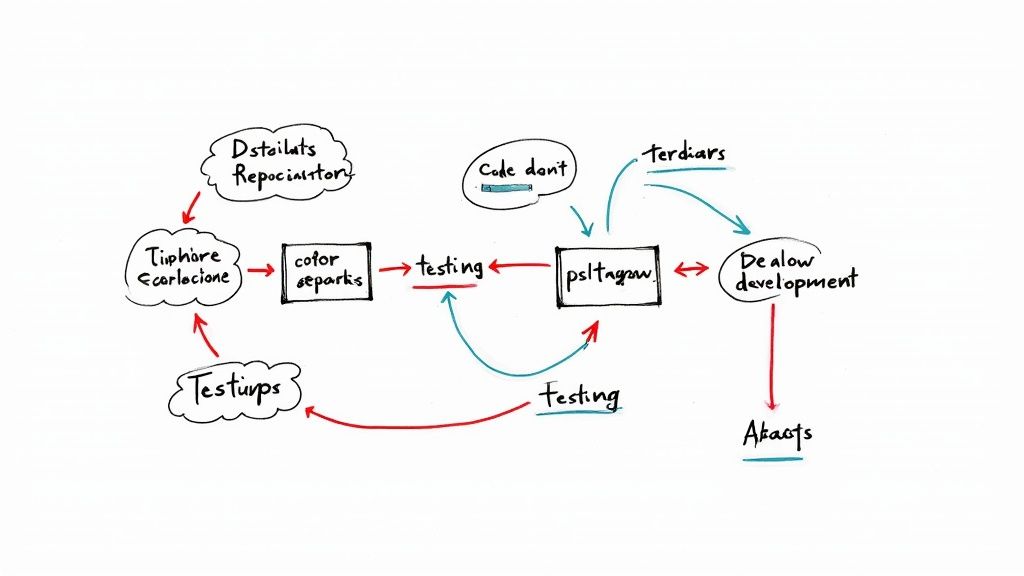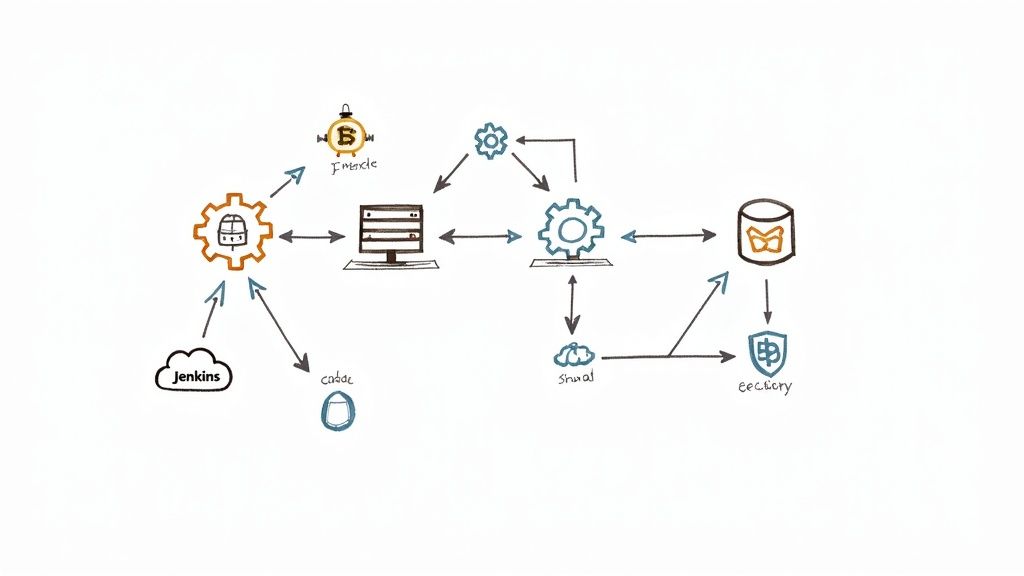Test Driven Approach: Expert Guide to Building More Reliable Software
Transform your software development with proven test driven strategies that boost code quality and slash defects by up to 90%. Learn practical approaches from real-world studies at Microsoft and IBM.

Test-driven development (TDD) has proven itself far beyond theory. Real results from engineering teams at Microsoft and IBM show that adopting TDD reduces defects by 40-90% in production code. These remarkable numbers come from actual projects, not just lab experiments. But what makes this approach so effective? The answer lies in how TDD fundamentally changes how developers think about and write code.
The Psychology of "Test-First"
Writing tests before code shifts how developers approach problems. Instead of diving straight into implementation, they must first clearly define what success looks like through test cases. This forces careful consideration of edge cases and potential issues upfront, similar to planning a route before starting a journey. The tests create guardrails that guide development and catch problems early. When developers need to modify code later, these tests act as an early warning system, flagging potential issues before they reach production.
Building Maintainable Code Through TDD
TDD naturally leads to more manageable code. Each test serves as a small, specific requirement that the code must satisfy. This approach breaks down complex features into clear, testable pieces - like creating a detailed blueprint before construction begins. The result is code that's easier to understand, change, and fix. Teams find that this structured approach makes their codebases more accessible to new team members and simpler to maintain over time. You might be interested in: Navigating through our posts.
Practical Implementation and Real-World Success
Teams that succeed with TDD make it part of their daily work, not just an occasional practice. They set clear testing standards, use appropriate tools, and build testing into their team culture. While teams often see development time increase by 15-35% when first adopting TDD, they typically save more time later through faster debugging and fewer production issues. This initial slowdown is like learning to touch type - it feels slower at first but leads to greater speed and accuracy over time.
From Theory to Practice
Starting with TDD requires commitment and patience. Developers need to build new habits and resist the urge to jump straight into coding. However, teams consistently report that the investment pays off through better code quality, fewer bugs, and more confident releases. As developers become comfortable with TDD, they often find they write code faster and understand their systems better. This leads to more job satisfaction and stronger team morale, creating a positive cycle that benefits both the code and the people who work on it.
Getting Past the TDD Learning Curve

Test-driven development brings clear benefits, but getting started isn't always easy. Many development teams find it challenging to shift their mindset and workflow patterns when first adopting TDD. Research shows that about 56% of teams face initial difficulties with the transition. However, with the right approach and expectations, teams can successfully integrate TDD into their development process.
Understanding the Initial Challenges
The biggest hurdle teams face is the initial impact on development speed. Writing tests before code feels unnatural at first, especially with project deadlines approaching. It's similar to learning any new skill - there's always an awkward phase at the start. Studies show that teams typically see a 15-35% increase in development time during early TDD adoption. But like learning to type properly, this temporary slowdown leads to much better speed and accuracy once the skill becomes second nature.
Building Confidence and Momentum
Success with TDD starts with building team confidence through small wins. Begin by applying test-driven practices to simpler, isolated components before tackling complex features. This controlled approach helps developers see TDD's benefits firsthand while building their skills in a low-pressure environment.
Good team support also makes a big difference. Creating spaces for developers to share experiences and learn from each other helps everyone feel more comfortable with the transition. Regular pair programming sessions, test-focused code reviews, and internal learning workshops give team members the guidance they need. When everyone feels supported, the whole team adapts more smoothly to the new workflow.
Addressing Common Pitfalls
Teams often struggle with writing effective tests at first. Complex, unclear tests can become hard to maintain, defeating the purpose of TDD. The key is keeping tests simple, focused and easy to understand. Well-designed tests should help document and verify the code's behavior without becoming a burden.
Another common mistake is skipping the refactoring step. TDD works in cycles - write a test, implement the code, then improve the design through refactoring. When teams rush past refactoring, technical debt builds up quickly. Making refactoring a consistent part of the workflow helps keep the codebase clean and flexible as it grows. By recognizing and actively working through these challenges, teams can successfully integrate TDD and enjoy its long-term benefits for code quality and maintainability.
Measuring What Actually Matters in TDD

Getting good test coverage is just the start - it doesn't guarantee well-designed or maintainable code on its own. To really understand if your test-driven development (TDD) approach is working, you need to look at metrics that show whether your code is becoming clearer, more flexible, and easier to change over time. Let's explore the key signs that tell you TDD is actually improving your codebase.
Key Metrics for Evaluating TDD Effectiveness
A few specific code metrics can tell you a lot about how well your test-driven approach is working. The weighted methods per class (WMC) metric shows how complex each class is based on its methods. When a class has a high WMC score, it's often trying to do too many things, making it harder to test and maintain properly.
The depth of inheritance tree (DIT) metric reveals how many layers of inheritance your classes have. Deep inheritance trees cause problems because changes ripple down through many levels - like pulling out a block in Jenga and watching the whole tower shake. Making even small updates becomes risky when inheritance goes too deep.
Object coupling (CBO) measures how interlinked your classes are with each other. The more tightly coupled classes are, the harder it is to change one without affecting many others. High coupling scores mean simple updates require touching lots of different parts of the code.
How TDD Influences These Metrics
Writing tests first naturally guides developers toward creating smaller, more focused classes and methods, which helps keep WMC scores lower. For example, when you write a test for specific behavior, you're more likely to create a dedicated method for just that purpose rather than cramming multiple behaviors into one big method.
TDD also helps teams spot inheritance issues early through tests, encouraging them to use composition instead. This typically leads to shallower inheritance trees and more flexible designs that are easier to change safely.
The test-first approach promotes designing with interfaces and dependency injection, which reduces direct coupling between classes. This means classes interact through clean interfaces rather than being tightly bound to specific implementations. As a result, you can change one class without having to update many others.
Tracking and Interpreting the Metrics
While various tools can track these metrics, the numbers only make sense in the context of your specific project. There's no universal "good" or "bad" score - what matters is the trend over time. For instance, if you see WMC steadily climbing across your codebase, it suggests complexity may be getting out of hand. On the flip side, decreasing CBO scores after adopting TDD indicate you're moving toward a more maintainable design with looser coupling.
By monitoring these metrics and understanding how TDD affects them, you get clear signals about whether your test-driven approach is actually leading to better code. This insight helps ensure TDD is delivering real benefits and guides you toward building a healthier, more sustainable codebase over time.
Making TDD Work for Your Team

Getting test-driven development (TDD) to work well requires more than just knowing the basics - it needs the whole team to embrace a testing mindset. Teams need to find the right balance between thorough testing and maintaining development speed based on their specific needs. When implemented thoughtfully, TDD can boost productivity significantly - some teams have seen gains of up to 50% after adopting it effectively.
Balancing Comprehensive Testing With Development Speed
Many developers worry that writing tests first will slow them down. While it does take more time upfront, this investment prevents bigger problems later. Think of it like constructing a building - a solid foundation may take longer initially but prevents costly repairs down the road. The tests you write through TDD catch bugs early before they become major issues, helping teams work steadily and deliver reliable code. For more on this topic, check out our sitemap of pages.
Maintaining Testing Discipline During Crunch Time
When deadlines get tight, testing often gets cut. But keeping up testing discipline, even under pressure, is essential for long-term success. TDD gives teams a clear framework to follow - write tests first, implement code to pass them, then refactor and improve. By sticking to these core steps even during busy periods, teams avoid taking shortcuts that lead to quality issues and technical debt that can derail projects later.
Adapting TDD Practices for Different Project Types
Not every project needs the same testing approach. A small, focused project might benefit from strict TDD practices, while a large, evolving system may need more flexibility. The key is understanding TDD's main principles and adjusting them based on your specific context. This could mean focusing on certain types of tests, deciding what level of coverage makes sense, or blending TDD with other development methods your team uses.
Overcoming Common TDD Challenges
Teams often face hurdles when adopting TDD - from writing effective tests to keeping up good testing habits over time. The good news is these challenges can be overcome. Open communication within the team, learning together, and continually improving your approach make a big difference. Having good testing tools and frameworks also helps teams embrace TDD more easily. By tackling these challenges directly, teams can get the most out of TDD while building a culture focused on quality.
Building a Team That Embraces Testing
Learning to value and embrace testing, particularly test-driven development (TDD), requires a fundamental shift in mindset. Moving away from treating tests as an afterthought, teams need to see testing as a core part of their development process right from the start. While this transition can be uncomfortable at first, having a team that genuinely believes in TDD leads to significant improvements in code quality and development speed.
Overcoming Resistance to Change
When introducing TDD, developers often worry that writing tests first will limit their creativity or slow them down unnecessarily. The key is addressing these concerns openly and directly. Think of TDD like sketching before painting - it provides helpful guidelines that actually give you more freedom to experiment safely. Showing how TDD leads to cleaner, more modular code helps teams see past their initial hesitation.
Fostering a Culture of Quality
Getting your team excited about TDD means highlighting how it makes their work better and easier. Yes, there's an adjustment period - like learning to type properly instead of hunt-and-peck. But the payoff comes quickly: fewer bugs to chase down, more reliable code, and less time spent debugging issues in production. Teams usually find that after the initial learning curve, TDD actually speeds up development by catching problems early when they're easier to fix.
Practical Strategies for Encouraging TDD Adoption
Here are some concrete ways to help your team embrace test-driven development:
-
Start Small and Build Momentum: Begin with simple, contained components where TDD's benefits are clear and quick to see. As developers gain confidence with the basics, they can gradually take on more complex testing scenarios. It's like learning music - you start with scales before tackling a concerto.
-
Provide Training and Support: Run hands-on workshops to teach TDD principles and practices. Set up pair programming sessions focused specifically on testing techniques. Having developers learn together creates shared knowledge and mutual support for better testing practices.
-
Celebrate Successes and Recognize Contributions: Call attention to teams doing great work with TDD. Share specific examples of how good tests prevented bugs or made changes easier. This positive reinforcement helps create momentum for broader adoption.
-
Integrate Testing into the Development Workflow: Make testing a natural part of how work gets done, not an extra task. Include testing in sprint planning and track it alongside other development work. When testing is woven into daily routines, it becomes second nature rather than feeling like overhead.
Putting these approaches into practice helps teams make TDD part of their core development process. The result is consistently better code that's easier to maintain and update. Most importantly, developers gain confidence that their changes won't break existing functionality, leading to faster development and happier teams.
Scaling TDD Across Your Organization
While getting test-driven development (TDD) working well within a small team is a great first step, expanding those practices across a larger organization brings its own set of challenges. The key is finding ways to scale TDD effectively as your company grows without creating bottlenecks or sacrificing quality.
Maintaining Consistency Across Multiple Teams
When scaling TDD practices, getting all teams aligned can be tricky. Teams often have varying levels of TDD experience, which can lead to inconsistent testing practices and make code integration more difficult. To address this, start by creating clear testing standards for the organization - specify expected test coverage levels, what types of tests to write, and which testing frameworks to use. Regular training sessions and workshops help get everyone up to speed on best practices. Having a central repository of testing resources gives teams an easy reference point when they need guidance.
Integrating New Tools and Frameworks
Growth often means adopting new technologies, so you'll need to smoothly incorporate them into your TDD workflow. This requires carefully evaluating how new tools fit with your existing testing setup and adjusting your testing approach accordingly. For example, if you start using a new frontend framework, you may need to add specific testing libraries or modify your integration testing strategy. Keeping up with developments in the testing world helps you make smart choices about which tools to bring in and how to use them effectively.
Evolving Your TDD Practice
Your approach to TDD needs to grow along with your organization. As projects become more complex, consider exploring additional testing techniques like behavior-driven development (BDD) or property-based testing. Regular reviews of your testing standards help ensure they still serve your organization's needs. Learn more in our article about authors and contributors. By continuously refining your practices, you can keep TDD working smoothly even as you scale.
Measuring Success and Ensuring Sustainability
To evaluate how well TDD is working at scale, look beyond basic test coverage metrics. Focus on measurements that show real impact, such as:
- How many defects appear in production
- Time spent debugging issues
- Number of regressions from new changes
Getting feedback directly from development teams provides valuable insights into what's working and what needs improvement. This data-driven approach helps you show TDD's value to stakeholders while making informed decisions about optimizing your testing strategy.
Make your development process smoother and improve code quality with Mergify. Our platform handles merge automation, helps enforce testing standards, and makes it easier to scale TDD across your organization. Visit Mergify to learn more and try it for free.





